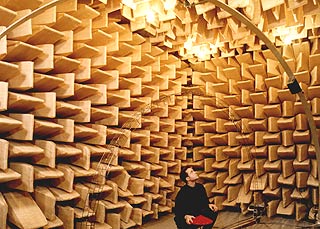skip to main |
skip to sidebar
SYNOPSIS: Were echoes the inspiration for cave paintings? This web page describes my scientifically testable theory about prehistoric art correlating with echoing locations, suggesting sound as a motivation for cave paintings and petroglyphs. The cultural significance of echoes is shown by myths that attribute echoes to spirits. An implication of this research is the previously unrecognized need for the conservation of the natural acoustical properties of the environment around rock art sites. NEWS: A new book entitled "Archaeoacoustics" is now available; it contains a chapter entitled "Intentionality of Rock-art Placement Deduced from Acoustical Measurements and Echo Myths" by Steven J. Waller. The book is a McDonald Institute Monograph edited by Scarre, C. & G. Lawson, Cambridge: McDonald Institute for Archaeological Research.
http://www.geocities.com/CapeCanaveral/9461/

Acoustic anechoic chambers are used for measuring the acoustic properties of musical instruments, determining the transfer functions of electro-acoustic devices, testing microphones and other audio equipment and performing psychoacoustic experiments (such as measuring the quality of audio codecs or measuring heat-related transfer functions). Echoes are surpressed within the chamber by the installation of acoustically absorptive material covering all of the internal surfaces. Attenuation of echoes in this way also greatly reduces reverberation. To the human ear acoustic anechoic chambers have the characteristic of being muted, muffled, and silent. Most acoustic anechoic chamber tests are also susceptible to acoustic noise penetrating the chamber from the external environment. This is minimised using sound proofing or acoustic isolation which may be achieved by encasing the chamber in a shell of dense, highly absorptive material such as cement, typically about a metre thick. The chamber may also provide additional isolation by being a completely independent shell mounted on rubber shock absorbers inside another room with no connections between them other than for essential services such as cables.
Anechoic chambers, modeled after the world's first wedge-based anechoic chamber at Murray Hill, Bell Labs, typically use fiberglass wedges (Anechoic tile) on the internal surfaces to absorb incident sound waves. The wedge shapes act as a waveguide to focus incoming sound into the fiberglass wedge, where the acoustic energy is converted to heat. The alternating pattern is used to achieve a more uniform angular absorption. Frequencies below about 200 Hz are not as effectively absorbed by the wedges. Anechoic chambers in which the bottom is also composed of wedges have the floor formed by a wire mesh suspended above the bottom by wires. Other anechoic chambers only use wedges for five of the six sides of the room.
John Cage, a 20th century composer, cited his experience in 1951 in Harvard University's anechoic chamber — a room in which he expected to hear nothing, but heard instead what was believed to be the sound of his own bloodflow and nervous system — as the inspiration for his famous "silent" composition, 4' 33".
Anechoic-chamber technology is also used in soundproofing rooms for indoor shooting ranges, and for hearing aid test chambers.
http://en.wikipedia.org/wiki/Anechoic_chamber
Acoustic Shadows From the most reverberant room in the world to a chamber where sounds die the moment they almost leave your mouth, Robert Sandall takes a journey into the world of acoustics - its origins, its people and some of its amazing soundscapes. Steve Waller travels the globe seeking out unusual acoustic sites in caves mountainsides and canyons and is convinced that much of the ancient rock art found there from ancient civilisations is created in response to each sites unique acoustical properties. If ancient man was sensitive to great acoustics, how in the modern age have we been able to control and manipulate the reverberations and echoes of the indoor space? Acoustics is a modern science that grew out of an ancient art. We all know when a room echoes uncomfortably or when it flatters an orchestra in a concert hall. But how exact is it? The Royal Festival Hall on London 's South Bank for instance became the first public building that was designed with proper researched acoustics, but its sound reverberations have proved hugely unpopular. Now with an attempt to entice back leading international orchestras, the hall is finally undergoing an acoustic revamp. Larry Kirkegaard is the acoustic engineer charged with restoring the acoustic to the original dream but how enticing will its new soundscape prove to be? Robert Sandall experiences audio treats, from echoes of ancient Mayan temples through to Brian Eno's virtual electronic world of ambient echoes, to assess what makes a good acoustic and how to create the perfect reverberation to appeal to our senses and flatter both audience and performers in a public space.http://www.bbc.co.uk/radio4/science/acousticshadows.shtml/

